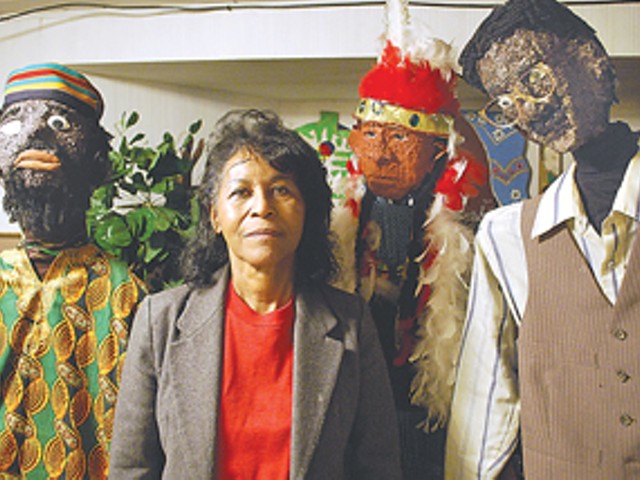Wrong Place, Wrong Time: Trauma and Violence in the Lives of Young Black Men
by John A. Rich
Johns Hopkins University Press, $24.95, 232 pp.
Tayvon pulls his shirt back down after showing me the scar that extends below his waistband to his groin and up to his sternum. About an inch wide, raised, milky sheen standing out from his caramel skin with symmetrical dots framing the disfiguration, marking where the sutures pulled the flesh back together after the surgeons repaired the internal damage the bullet caused when it passed through his belly.
"See this?" He points to a small scar at his hairline. "That's where I was pistol-whipped. Now that shit was really fucked-up."
Tayvon is a small, wiry, baby-faced 18-year-old in a Baltimore prison when he tells offhandedly about this comparative value of his physical traumas. His red rubber bracelet marks his street affiliation and he tells me without affectation that there is nothing he can do to escape violence in Baltimore (a sentiment echoed for decades in Detroit).
That culture of violence — its omnipresence, its inexorability and the powerful physical and psychological scars it has left on the young men of Baltimore, Detroit and so many other urban neighborhoods in America — is the subject of John A. Rich's vital new book Wrong Place, Wrong Time: Trauma and Violence in the Lives of Young Black Men (Johns Hopkins University Press). Rich chairs the Department of Health Management and Policy at the Drexel University School of Public Health and is director of the Center for Nonviolence and Social Justice. He's also a MacArthur Fellow and founder and practicing doctor at the Young Men's Health Clinic in Boston.
While homicide continues to be the leading cause of death for African-American men between 15 and 34, and while most Americans take the measure of urban violence with the cold accounting of the number of bodies that accumulate during a calendar year, Rich is after something more. "Homicide represents only the tip of the iceberg," he writes. There are all of those non-fatal shootings, stabbings and beat-downs. "Countless others suffer trauma or near-trauma that never comes to the attention of the health care system. ..."
We now have several generations of urban soldiers who have grown into, been affected by and perpetuated this culture of violence, and Rich was struck by how little research had gone into thinking through the role of trauma in the lives of urban young men. The research elsewhere — notably on soldiers in war and victims of domestic violence — was clear in the powerful social and psychological consequences of traumatic experience. The common symptoms of what we have come to know as post-traumatic stress disorder — hyper-vigilance, inability to feel, a desire to return to danger to master one's fears, self-medication with drugs and alcohol, depression — were clearly observable to anyone who has spent time with young, urban men.
The social costs of trauma were less often clear, and Rich makes a compelling case that it's something pop-sociological theories often miss. He recasts a common theory: "Fragmentation of urban families, while often attributed to lack of responsibility on the part of the father, may have significant roots in trauma itself. We know that traumatized people can find it difficult to connect to loved ones and feel. We also know that in the setting of poverty and lack of opportunity young men may find it difficult to fulfill their responsibilities, even if they desire to do so."
What Rich points out is that traumatized urban young men live with a perpetual feeling of being unsafe. What traumatized people do — sometimes masked with the cool pose of urban machismo — is go to extreme lengths to protect themselves, often doing whatever it takes to get a weapon.
Wrong Place is no academic, theoretical treatise, however. The book is a very personal story. Rich confronts his own biases about the young victims and perpetrators of urban violence and the near consensus among his fellow health-care providers and the public at large that the young male victims of urban violence either brought it on themselves or deserve what they got.
What Rich does for the bulk of the book to counter the broad strokes of such generalization is to tell the stories of specific young men who were caught up in this culture of violence. He mostly meets them in emergency rooms, intensive care units or prison; but more, he questions them, follows them beyond their injuries, records their voices, and in his relationships with these young men he chronicles his own growing, changing understanding of violence and trauma in their lives.
Without hearing those voices and challenging our preconceptions, Rich writes, "we could easily formulate solutions that are out of sync with the realities of their lives and that would be ineffective or outright destructive." There is plenty of evidence that our current attempts at solutions are indeed out of sync.
"Wrong place, wrong time" was the phrase many young men offered to Rich as an explanation of how they encountered violence. It captures their sense of both the fatalism and arbitrariness of urban violence; a fatalism and arbitrariness that we on the outside of such experience often feel when pursuing solutions.
Michael Corbin is a freelance writer. Send comments to [email protected]




